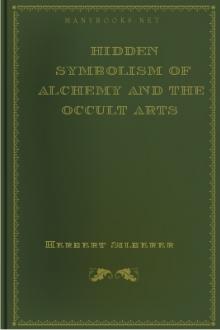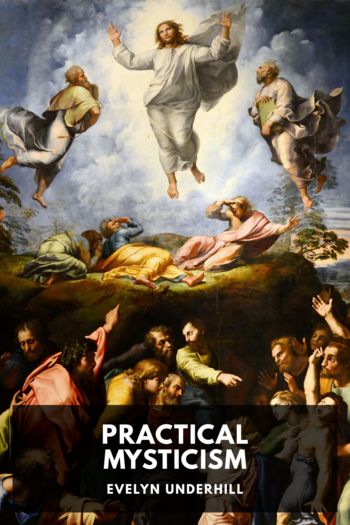Hidden Symbolism of Alchemy and the Occult Arts by Herbert Silberer (e book reader free .txt) 📕

- Author: Herbert Silberer
- Performer: -
Book online «Hidden Symbolism of Alchemy and the Occult Arts by Herbert Silberer (e book reader free .txt) 📕». Author Herbert Silberer
John XIX, 33. “But when they came to Jesus, and saw that he was dead already, they brake not [pg 085] his legs.”—40 f. “Then took they the body of Jesus and wound it in linen cloths with the spices.... Now in the place where he was crucified there was a garden, and in the garden a new sepulcher, wherein was never man yet laid.”
We shall mention later the significance of garden and grave. It supports that of the cloths.]
Rank considers that the circumstance that the dismembered person or animal resurrected generally lacks a member, points without exception to castration.
What he has said about dismemberment we can now sum up with reference to the lion in the parable in the formulae: Separation of parents; the pushing aside of the father; castration of father; taking his place; liberation of the power of procreation; improvement. In its bearing on the incest wish, castration is indeed the best translation of the “anatomizing” of the lion. The dragon fighter has to release a woman. The idea that the mother is in need of being released, and that it is a good deed to free her from her oppressor, father, is according to the insight of psychoanalysis a typical element of those unconscious phantasies of mankind, which are stamped deeply with the greatest significance in the imaginative “family romance” of neurotics. To the typical dragon fight belongs, however (according to Stucken's correct formulation), the motive of denial. As a matter of fact the hero of our parable is denied the prize set before him—the admission into the college—for several of the [pg 086] elders insist on the condition that the wanderer must resuscitate the lion (Sec. 7). In myths where the dragon has to fight with a number of persons this difference generally occurs: that he produces dissension among his opponents. (Jason throws a stone among the men of the dragon's teeth, they fight about the stone and lay each other low.) Dissension occurs also among the old men. They turned (Sec. 7) “fiercely on each other” if only with words.
The wanderer removes, as it were, an obstacle by the fight, tears down a wall or a restraint. This symbol occurs frequently in dreams; flying or jumping over walls has a similar meaning. The wanderer was carried as if in flight to the top of the wall. Then first returns the hesitation. The symbolism of the two paths, right and left, has already been mentioned. The man that precedes the wanderer (Sec. 7 and 8) may be quite properly taken as the father image; once, at any rate, because the wanderer finds himself on the journey to the mother (that is indeed the trend of the dream) and on this path the father is naturally the predecessor. The father is, however, the instructor, too, held up as an example and as a model for choosing the right path. The father follows the right path to the mother also; he is the lawful husband. The son can reach her only on the left path. This he takes, still for the purpose of making things better. Some one follows the wanderer on the other side (Sec. 8), whether man or woman is not known. The father [pg 087] image in front of the wanderer is his future for he will occupy his father's place. The Being behind him is surely the past, the careless childhood, that has not yet learned the difference between man and woman. It does not take the difficult right way, but quite intelligibly, the left. The wanderer himself turns back to his childish irresponsibility; he takes the left path. The many people that fall down may be a foil to illustrate the dangers of the path, for the purpose of deepening the impression of improvement. Phantasies of extraordinary abilities, special powers; contrasts to the anxiety of examinations; all these in the case of the wanderer mark the change from apprehension to fulfillment. We must not fail to recognize the element of desire for honor; it will be yet described. In view of myth motives reported by Stucken, the entire wall episode is to be conceived as a magic flight; the people that fall off are the pursuers.
At the beginning of the ninth section of the parabola, the wanderer breaks red and white roses from the rosebush and sticks them in his hat. Red-white we already know as sexuality. The breaking off of flowers, etc., in dreams generally signifies masturbation; common speech also knows this as “pulling off” or “jerking off.” In the symbolism of dreams and of myths the hat is usually the phallus. This fact alone would be hardly worth mentioning, but there are also other features that have a similar significance. The fear of impotence points to autoerotic components in the psychosexual constitution of [pg 088] the wanderer (of course not clearly recognized as such), which is shown as well in the anxiety about ridicule and disgrace that awaken ambition. This is clearest in the paragraphs 6, 10, 14, of the parable. That the masturbatory symbol precedes the subsequent garden episode, can be understood if we realize that the masturbation phantasy (which has an enormous psychic importance) animates or predetermines the immediately following incest.
The wall about the garden that makes the long detour necessary (Sec. 9) is as we know the resistance. Overcoming the resistance = going round the wall, removal of the wall. Of course, after the completion of the detour there is no wall. The wall, however, signifies also the inaccessibility or virginity of the woman. The wall surrounds a garden. The garden is, however (apart from the paradise symbolism derived from it), one of the oldest and most indubitable symbols for the female body.
Without much change the same symbolism is found in stately form in the Melker Marienlied of the 12th century. (See Jung, Jb. ps. F., IV, S. 398 ff.)
[pg 089]Note also the garden, roses and fountains in the Song of Solomon.
The wanderer wishes to possess his mother as an unravished bride. Also a feature familiar to psychoanalysis. The generally accompanying antithesis is the phantasy that the mother is a loose woman = attainable, sexually alluring woman. Perhaps this idea will also be found in the parable.
The young people of both sexes, separated by a wall, do not come together because they are afraid of the distant detour to the door. This can, with a little courage, be translated: The auto-erotic satisfaction is easier.
[C G. Jung writes (Jb. ps. F., IV, p. 213 ff): “Masturbation is of inestimable importance psychologically. One is guarded from fate, since there is no sexual need of submitting to any one, life and its difficulties. With masturbation one has in his hands the great magic. He needs only to imagine and in addition to masturbate and he possesses all the pleasures of the world and is under no compulsion to conquer the world of his desire through hard work and struggle with reality. Aladdin rubs his lamp and the slaves come at his bidding; this story expresses the great psychologic gain in local sexual satisfaction [pg 090] through facile regression.” Jung applies to masturbation the motive of the dearly won prize and that of the stealing of fire. He even appears to derive in some way the use of fire from masturbation. In this at any rate I cannot follow him.]
On his detour the wanderer (who desires to reach the portal of woman) meets people who are alone in the rooms and carry on dirty work. Dirt and masturbation are wont to be closely associated psychically. The dirty work is “only appearance and individual fantasy,” and “has no foundation in Nature.” The wanderer knows that “such practices vanish like smoke.” He has done it himself before and now he will have nothing more to do with it. He aspires to a woman, that the work done alone leads to nothing is connected with the fact that the work of two is useful. But “dirty work” is also to be understood as sensual enjoyment without love.
In paragraph 10 we again meet the already mentioned symbolism of the walled garden. The wanderer is the only one that can secure admission to the maiden. After a fear of impotence (anxiety about disgrace) he goes resolutely to the door and opens it with his Diederich, which sticks into a narrow, hardly visible opening (deflowering). He “knows the situation of the place,” although he has never been there before. I mean that once, before he was himself, he was there in the body of his mother. What follows suggests a birth fantasy as these occur in dreams of being born. The wanderer now actually takes part in being born in reverse direction. [pg 091] I append several dreams about being born.
“I find myself on a very narrow stairway, leading down in turns; a winding stairway. I turn and push through laboriously. Finally I find a little door that leads me into the open, on a green meadow, where I rest in soft luxuriant bushes. The warm sunshine was very pleasant.”
F. S. dreams: “In the morning I went to work with my brother (as we went the same road) in the Customs House Street. Before the customs house I saw the head postillion standing. From it the way led to a street between two wooden walls; the way appeared very long and seemed to





Comments (0)